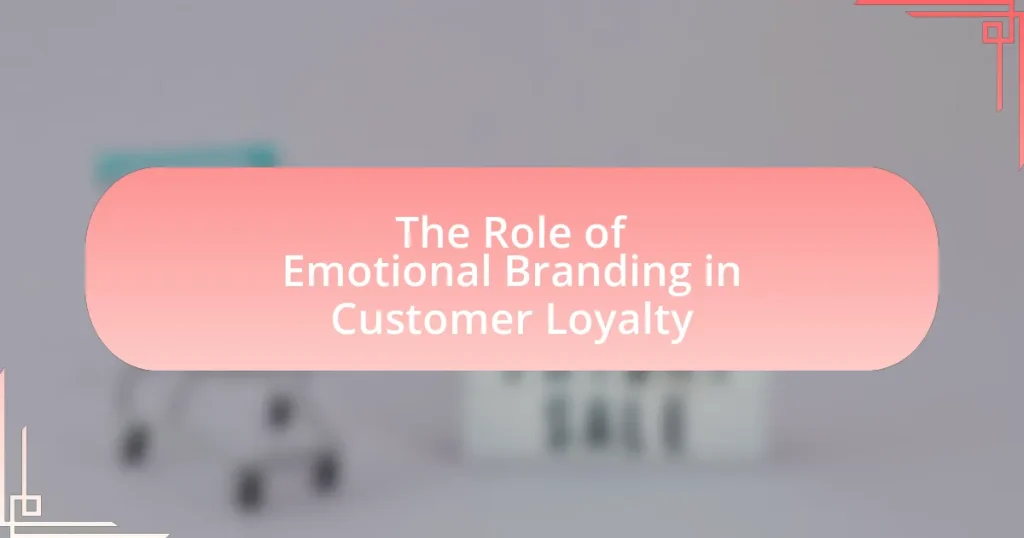Emotional branding is a marketing strategy designed to forge strong emotional connections between brands and consumers, significantly enhancing customer loyalty. This article explores how emotional branding influences consumer behavior, the psychological factors involved, and the impact of emotions on purchasing decisions. It highlights the importance of customer loyalty for businesses, detailing the benefits of loyal customers and their effect on a company’s profitability. Key elements of emotional branding, such as storytelling and brand identity, are discussed, along with strategies for effective implementation and the challenges brands face in maintaining emotional connections. The article concludes with best practices to enhance emotional branding for increased customer loyalty.

What is Emotional Branding and its Role in Customer Loyalty?
Emotional branding is a marketing strategy that aims to create a strong emotional connection between a brand and its customers. This connection fosters customer loyalty by making consumers feel understood, valued, and emotionally invested in the brand. Research indicates that brands that successfully engage customers on an emotional level can achieve higher customer retention rates; for instance, a study by the Harvard Business Review found that emotionally connected customers are more than twice as valuable as highly satisfied customers. This demonstrates that emotional branding not only enhances customer loyalty but also drives long-term business success.
How does Emotional Branding influence consumer behavior?
Emotional branding significantly influences consumer behavior by creating strong emotional connections between consumers and brands. These connections lead to increased brand loyalty, as consumers are more likely to choose brands that resonate with their feelings and values. Research indicates that emotionally connected customers are 52% more valuable than those who are just satisfied, as they tend to exhibit higher levels of engagement and repeat purchases. This emotional engagement drives consumers to prefer brands that evoke positive feelings, ultimately shaping their purchasing decisions and fostering long-term loyalty.
What psychological factors are involved in Emotional Branding?
Emotional branding involves several psychological factors, including emotional connection, brand loyalty, and consumer identity. Emotional connection refers to the feelings and associations consumers develop towards a brand, which can significantly influence their purchasing decisions. Research indicates that brands that evoke strong emotions can create lasting loyalty; for instance, a study by Thomson, MacInnis, and Park (2005) found that emotional attachment to a brand leads to increased loyalty and advocacy.
Brand loyalty is another critical psychological factor, as it reflects a consumer’s commitment to repurchase or continue using a brand despite potential alternatives. This loyalty is often driven by positive emotional experiences associated with the brand. Additionally, consumer identity plays a role, as individuals often choose brands that align with their self-image or values, reinforcing their emotional connection. A study published in the Journal of Consumer Research by Aaker (1999) highlights how brand personality traits can resonate with consumers’ identities, further solidifying their emotional ties to the brand.
These psychological factors collectively enhance the effectiveness of emotional branding in fostering customer loyalty.
How do emotions drive purchasing decisions?
Emotions significantly influence purchasing decisions by shaping consumer perceptions and driving behavior. Research indicates that emotional responses can lead to increased brand loyalty, as consumers often make choices based on feelings rather than rational analysis. For instance, a study published in the Journal of Consumer Research found that emotional branding can enhance customer attachment to a brand, resulting in a 23% increase in customer loyalty. This demonstrates that when brands evoke positive emotions, such as happiness or nostalgia, consumers are more likely to choose their products over competitors, reinforcing the critical role emotions play in purchasing decisions.
Why is Customer Loyalty important for businesses?
Customer loyalty is important for businesses because it leads to increased revenue and profitability. Loyal customers tend to make repeat purchases, which can significantly boost a company’s sales. According to a study by Bain & Company, increasing customer retention rates by just 5% can increase profits by 25% to 95%. Additionally, loyal customers are more likely to refer others, reducing customer acquisition costs. This creates a sustainable competitive advantage, as retaining existing customers is generally less expensive than acquiring new ones.
What are the benefits of having loyal customers?
Loyal customers provide significant benefits to businesses, including increased revenue, reduced marketing costs, and enhanced brand reputation. These customers tend to spend more over time; for instance, a study by Bain & Company found that increasing customer retention rates by just 5% can lead to a profit increase of 25% to 95%. Additionally, loyal customers are more likely to refer others, which lowers the cost of acquiring new customers. They also contribute to a positive brand image, as their satisfaction often leads to word-of-mouth promotion. This cycle of loyalty fosters a stable revenue stream and strengthens the overall market position of a brand.
How does Customer Loyalty impact a company’s bottom line?
Customer loyalty significantly enhances a company’s bottom line by increasing repeat purchases and reducing customer acquisition costs. Loyal customers tend to spend more over time; for instance, a study by Bain & Company found that increasing customer retention rates by just 5% can lead to a profit increase of 25% to 95%. Additionally, loyal customers often refer new clients, further lowering marketing expenses. This relationship between customer loyalty and financial performance underscores the importance of emotional branding, which fosters deeper connections and encourages repeat business.
What are the key elements of Emotional Branding?
The key elements of Emotional Branding include brand storytelling, emotional connection, customer experience, and brand authenticity. Brand storytelling engages consumers by creating narratives that resonate with their values and experiences, fostering a deeper emotional connection. Emotional connection is crucial as it influences consumer loyalty; studies show that emotionally connected customers are more likely to remain loyal and advocate for the brand. Customer experience encompasses every interaction a consumer has with the brand, and positive experiences enhance emotional ties. Lastly, brand authenticity builds trust; research indicates that 86% of consumers consider authenticity important when deciding what brands they like and support.
How do brand stories contribute to Emotional Branding?
Brand stories contribute to emotional branding by creating a narrative that resonates with consumers on a personal level, fostering a deeper emotional connection. These narratives often encapsulate the brand’s values, mission, and customer experiences, which can evoke feelings of nostalgia, trust, or inspiration. For instance, a study by the Harvard Business Review found that brands with compelling stories can increase customer engagement and loyalty by up to 30%. This emotional engagement leads to stronger brand affinity, as consumers are more likely to choose brands that reflect their own values and experiences.
What role does brand identity play in fostering emotional connections?
Brand identity plays a crucial role in fostering emotional connections by creating a distinct image and personality that resonates with consumers. This identity encompasses elements such as logos, colors, messaging, and values, which together evoke specific feelings and associations in the minds of customers. For instance, brands like Apple and Nike utilize their identities to cultivate loyalty by aligning with consumers’ aspirations and lifestyles, leading to deeper emotional engagement. Research indicates that emotional branding can increase customer loyalty by up to 60%, demonstrating the effectiveness of a strong brand identity in establishing meaningful relationships with consumers.
How can businesses effectively implement Emotional Branding?
Businesses can effectively implement Emotional Branding by creating authentic emotional connections with their customers through storytelling, personalized experiences, and consistent brand messaging. By leveraging storytelling, brands can evoke emotions that resonate with their target audience, making the brand more relatable and memorable. For instance, brands like Nike use powerful narratives that inspire and motivate, which fosters a strong emotional bond with consumers. Personalized experiences, such as tailored marketing campaigns and customer interactions, enhance this connection by making customers feel valued and understood. Consistent brand messaging across all platforms reinforces the emotional identity of the brand, ensuring that customers associate specific feelings with the brand. Research indicates that emotionally connected customers are more likely to exhibit loyalty, with a study by the Harvard Business Review showing that emotionally engaged customers are three times more likely to recommend a brand and five times more likely to purchase again.
What strategies enhance the connection between Emotional Branding and Customer Loyalty?
Strategies that enhance the connection between Emotional Branding and Customer Loyalty include creating authentic brand narratives, fostering community engagement, and personalizing customer experiences. Authentic brand narratives resonate emotionally with consumers, leading to stronger identification with the brand; for instance, brands like Nike leverage storytelling to connect with their audience’s aspirations and values. Community engagement, such as through social media platforms, allows brands to build relationships and foster a sense of belonging among customers, which has been shown to increase loyalty. Personalization, through tailored marketing and customer interactions, enhances emotional connections by making customers feel valued and understood, as evidenced by studies indicating that 80% of consumers are more likely to make a purchase when brands offer personalized experiences.
How can storytelling be used to strengthen customer relationships?
Storytelling can strengthen customer relationships by creating emotional connections that resonate with customers’ values and experiences. When brands share authentic narratives that reflect their mission or customer journeys, they foster a sense of belonging and loyalty. Research indicates that emotionally connected customers are more likely to remain loyal, with a study by the Harvard Business Review showing that emotionally engaged customers are three times more likely to recommend a brand and five times more likely to purchase again. This demonstrates that effective storytelling not only enhances customer engagement but also drives long-term loyalty and advocacy.
What role does customer experience play in Emotional Branding?
Customer experience is crucial in emotional branding as it directly influences how consumers perceive and connect with a brand on an emotional level. Positive customer experiences foster emotional attachments, leading to increased brand loyalty and advocacy. Research indicates that brands that prioritize customer experience can achieve a 10-15% increase in customer retention rates, which is essential for building long-term loyalty. Furthermore, a study by PwC found that 73% of consumers consider customer experience a key factor in their purchasing decisions, highlighting the significant role that customer interactions play in shaping emotional connections with brands.
What are the challenges of Emotional Branding in building Customer Loyalty?
The challenges of emotional branding in building customer loyalty include the difficulty of consistently evoking genuine emotional responses, the risk of misalignment between brand messaging and customer expectations, and the potential for emotional fatigue among consumers. Emotional branding relies on creating strong emotional connections, but if a brand fails to maintain authenticity, it can lead to customer distrust. For instance, a study by the Harvard Business Review found that 64% of consumers cite shared values as the primary reason for a strong brand relationship, indicating that inconsistency can undermine loyalty. Additionally, emotional branding strategies may not resonate equally across diverse customer segments, leading to alienation of certain groups. This complexity necessitates careful market research and ongoing engagement to ensure that emotional appeals remain relevant and effective.
How can brands overcome negative perceptions?
Brands can overcome negative perceptions by actively engaging in transparent communication and demonstrating accountability. This approach involves acknowledging past mistakes, addressing customer concerns directly, and providing clear information about changes made to improve products or services. For instance, a study by the Harvard Business Review found that companies that openly communicate about their challenges and the steps taken to rectify them can rebuild trust and enhance customer loyalty. By fostering an emotional connection through authentic storytelling and consistent brand messaging, brands can shift consumer perceptions positively, ultimately leading to increased customer loyalty.
What are the risks of failing to connect emotionally with customers?
Failing to connect emotionally with customers can lead to decreased customer loyalty and increased churn rates. When businesses do not establish an emotional bond, customers are more likely to switch to competitors, as emotional connections significantly influence purchasing decisions. Research indicates that emotionally connected customers are more than twice as valuable as highly satisfied customers, as they tend to spend more and remain loyal longer. Additionally, a lack of emotional engagement can result in negative word-of-mouth, damaging a brand’s reputation and reducing potential customer acquisition. Therefore, the risks include loss of revenue, diminished brand loyalty, and potential harm to the company’s image in the marketplace.
What best practices can enhance Emotional Branding for Customer Loyalty?
To enhance emotional branding for customer loyalty, brands should focus on storytelling, personalization, and community engagement. Storytelling allows brands to connect with customers on a deeper level by sharing narratives that resonate with their values and experiences. Personalization tailors the customer experience, making individuals feel valued and understood, which fosters a stronger emotional connection. Community engagement builds a sense of belonging among customers, encouraging them to form emotional ties with the brand and each other. Research by the Harvard Business Review indicates that emotionally connected customers are more than twice as valuable as highly satisfied customers, demonstrating the effectiveness of these practices in driving loyalty.


